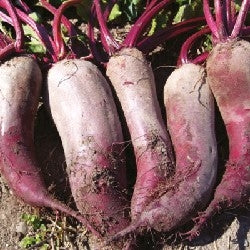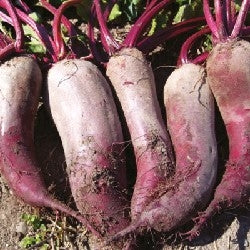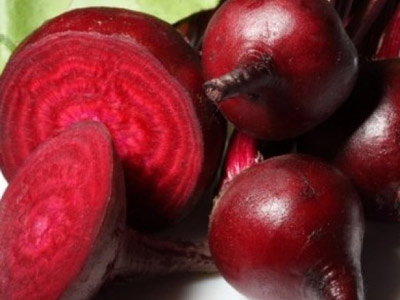BEETROOT FORMANOVA- ra18
Have a question?

BEETROOT FORMANOVA- ra18
Dettagli
Species: Beta vulgaris
Variety: esculenta
Family: Chenopodiaecaeae
Brief history and botanical notes on the plant
Like all beets, the red beetroot comes from the wild Beta vulgaris species which is native to the Mediterranean basin and the arid regions of Central Asia and the Middle East. From these areas it has spread eastwards and westwards to the North Sea. It is a species that has become very adaptable thanks to the skill of man who has managed to obtain, through continuous selection, multiple and lasting varieties. Already at the time of the ancient Greeks and Romans, red and white beetroot were cultivated, plants then used both for human consumption and as fodder for animals. The white variety later became the one used for the production of sugar. The different species easily produce hybrids with each other, in fact in a field of white-fleshed sugar beets, it is not uncommon to find some plants with light-pink or red-tinged flesh.
It differs from chard in the size of the root, which can reach 12 cm in diameter and in the shape of the leaves, equipped with a long stalk; the flap is smooth, spatula-shaped, green or green tinged with red; the fleshy root, globose, round, flattened or cylindrical, has a red external color and a pink-red to purplish-red pulp; the enlarged root continues with a thin radicle that does not reach great depths.
The biological and reproductive characteristics are similar to those of chard.
Family and variety
Red or vegetable beetroot, scientific name Beta vulgaris variety esculenta, belongs to the Chenopodiaceae family.
The cultivars are classified based on the shape of the root and the earliness of the crop cycle (early, medium-early, medium-late).
Pedoclimatic needs
Vegetable beetroot requires temperatures above 5-6°C to grow and can tolerate temperatures as low as -2°C. In the early stages of growth it is necessary to pay attention to temperatures below 10°C which, if they continue for a few weeks, can cause the plants to go to seed. By using TNT (non-woven fabric) it is possible to obtain a 2-3°C difference which allows you to avoid the risk.
Sowing and transplanting times
Sowing begins in mid-April and continues until the end of June: the seedlings emerge from the soil in 1-2 weeks. The distance between the rows is approximately 40 cm, but this measurement varies depending on the tool used to contain the wild herbs. In the rows it is advisable to space the beets about 10 cm apart to facilitate root growth. It is also possible to transplant in the same sowing period.
Fertilizations
Rustic and undemanding plant: low-medium consumer of nitrogen, low consumer of P and medium of K. All the Chenopopdiaceae are "greedy" consumers of nitrogen, but an excess of nitrates in plants unnecessarily compromises their healthiness as well as being superfluous for cultivation, furthermore excessive fertilization of nitrogenous compounds can encourage attacks by insects.
Products
There are no specific products reported for either defense or fertilization.
Crop care and irrigation
After sowing, thinning is carried out when the seedlings reach 5-7 cm in height to encourage harmonious development of the roots and seedlings. If you cultivate very clayey soil, light earthing may be useful, useful to prevent the roots from tending to "exit" partially from the soil, compromising the qualitative characteristics of the product.
Irrigation must be constant and frequent (every 3-4 days), particularly in the hottest and driest months of summer. It is essential not to exceed the quantities, the aim is to keep the soil moist and not soaked in order to avoid asphyxiation
roots and yellowing/withering of plants.
Adversity
Rustic plant, no particular adversities have been reported. However, the plant could suffer from the most dangerous foliar disease among beets: Cercospora (Cercospora beticola), also known as "pitting",
Among the agents that cause rotting of the roots and collar in the early stages of growth are Foot Pain (Phoma betae), Pythium and Rhizoctonia spp. The principle of adopting long rotations is above all valid for all of them.
Serious damage is also caused by some virosis transmitted by seed and by some insect vectors (Aphis fabae and Myzus persicae): Yellowworm virus and Mosaic virus.
The parasites that affect the chard with damage to the roots include polyphagous insects (mole crickets, noctules, elaterids), while aphids, the Altica (Chaetocnema tibialis), the Fly (Pegomya betae), the vegetable thrips (Thrips tabaci) produce damage on the leaves ), the two-spotted spider mite (Tetranychus urticae). In the latter case we recommend the use of pyrethrum to limit the damage.
Production and collection
The yield per square meter is approximately 3 kg of product. Harvesting begins when the diameter of the roots is 5-7 cm in order to avoid hardening of the tissues which compromises the organoleptic qualities of the roots.
Generally it takes 70-80 days. after sowing (40-60 after transplanting) so that the roots are ready to be consumed, it lasts for about 15-30 days.
For conservation it is useful to keep the roots "dirty" with earth by eliminating the leaf part which can be eaten cooked. Placed in a cool, dry place they can maintain their characteristics for 20-40 days.
Nutritional values
approximately 90% from water, proteins, carbohydrates, dietary fibre, vitamins and mineral salts such as sodium, potassium, iron, calcium and phosphorus.
Among the vitamins we include vitamin B1, B2, B3, traces of vitamin A and finally vitamin C. The characteristic red color of the roots of this beetroot is due to the presence of a real natural dye, E 162 , which is used in the food industry to improve the appearance of other foods.
Red beetroot is also rich in sugars and for this reason diabetics must pay attention to the way and dosages in which they consume it.
Biodynamics
Sowing or transplanting on root days in the descending moon, cultural care and harvesting on root days. Being a rustic plant, there are no particular strategies to use with the biodynamic method: good rotation, the use of mature compost and surface processing that allows the entry of air, light, water and heat are the basis for a simple and effective cultivation.



